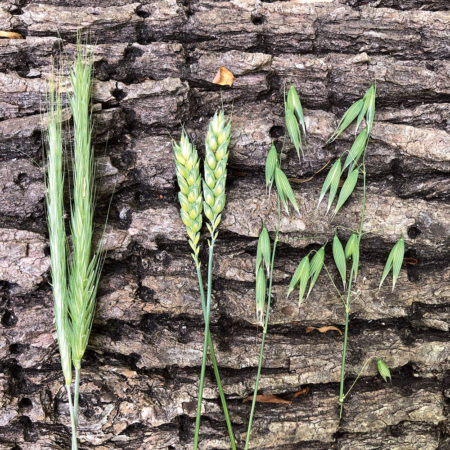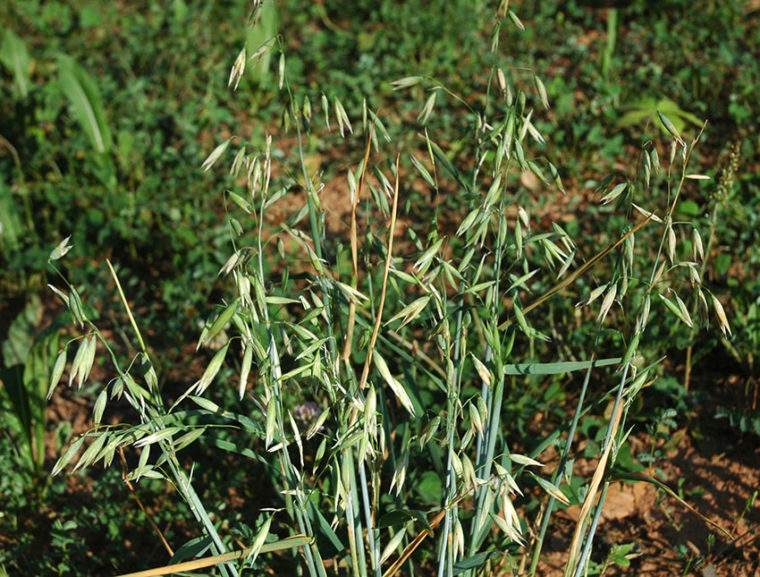It’s no secret that cereal grains – wheat, oats, cereal rye, triticale – are popular choices for planting in food plots managed for whitetails. Cereal grains are highly attractive to deer, and they perform well under a wide range of conditions. With regard to deer preference, oats consistently rank higher than the other cereal grains and most other forages for that matter.
Species Description
Oats (Avena sativa) are a cool-season annual cereal grain and look very similar to the other cereal grains during the early stages prior to flowering. However, experienced food plotters may notice that oats are a deeper green compared to the other grains. Also, when oats mature and produce a seed head, it is very easy to differentiate them from the others because its seed head is considered a panicle while the others have a spike. At maturity, oats typically reach about 2- to 3-feet tall if soil fertility is good.
As previously mentioned, oats are highly favored by deer and they consistently rank among the top species consumed by deer in forage preference trials. Oats are highly nutritious as well. In well-managed food plots with a neutral soil pH and good fertility, oats can contain more than 25% crude protein. This rivals any other cool-season forage and is well above the levels required by deer for optimum growth and production. Oats are also highly digestible. In fact, oats are one of the most digestible deer forages on the market, with an acid detergent fiber value registering below 20%. Acid detergent fiber is a measurement of the indigestible portion of the plant, so the lower the better.
Another appealing quality of oats is they germinate and grow very quickly, making it ideal as a nurse crop for slower growing perennial clovers and chicory, as well as providing early season hunting opportunities. Overall forage production during the fall/winter is very respectable at 3,000 to 4,000 lbs./acre (dry weight), and oats have excellent resistance to heavy grazing pressure.
One problem with oats is cold tolerance. In the northern half of the U.S., oats will be killed when cold weather sets in unless a cold-hardy variety is used. This is why oats are typically planted in the spring in northern regions except when trying to provide a quick source of attraction in fall hunting plots. Regardless, it is important to select a variety of oats that is cold hardy, which can be determined by contacting your local Extension agent or seed dealer. Also, oats do not perform well in wet, poorly-drained soils, so be sure to plant them on sites that are well drained.
Soil Preparation and Planting

The cereal grains rye, wheat and oats are difficult to tell apart in fall because they all appear as grassy forage. But in spring, when they produce seed heads, oats (far right) are easy to pick out from rye (far left) and wheat.
Prior to planting oats or other forages, it is important to collect soil samples to determine the soil pH and fertility of your plots. Doing so will allow you to add the recommended amount of lime (if needed) and fertilizer to maximize forage production, attraction, and nutritional quality. Oats definitely perform best and are most attractive to deer when the soil pH is 6.0 or greater and nutrient levels are maintained in the high range.
Similar to other cereal grains, oats are very easy to establish and can either be broadcast or drilled into a prepared seed bed. If broadcasting seed, be sure to create a smooth, firm seedbed by disking/tilling to ensure optimal germination and seedling establishment. If planting alone in a pure stand, broadcast seed at 120 to 150 lbs./acre PLS (pure live seed) and lightly disk into the soil 1- to 2-inches deep. Oats will not establish well if they are not incorporated into the soil with good seed-to-soil contact.
If no-till drilling, be sure to kill the existing vegetation with glyphosate a few weeks prior to planting to eliminate weed competition and expose the soil prior to planting. Oats should drilled at 70 to 80 lbs./acre PLS at 1- to 2-inches deep if planting alone.
If your goal is to extend the life of food plots into the following summer, it will be important to include other forages that will be available when the oats seed out and die in late spring. Planting a mixture will also help buffer against winter kill if a cold-hardy variety of oats is not used.
Oats perform very well in mixtures with other annual forages, such as crimson, arrowleaf, balansa and frosty berseem clovers, as well as winter peas and brassicas. I prefer including annual clovers because they can extend the life of the plot after oats mature, as well as produce nitrogen that benefits the oats. Otherwise you only get about 7 months of quality forage when planting oats alone. As oats begin to mature and produce seed, palatability and digestibility are significantly reduced.
Oats are an excellent choice for perennial clover/chicory plots as well. Oats germinate very quickly and provide early attraction as the slower growing clover and chicory emerge later. However, be sure to reduce the planting rate of oats to approximately 40 to 50 lbs./acre PLS with this strategy to avoid choking out the clover and chicory. Also, the height of oats, which is about 2 feet at maturity, is more accommodating than taller cereal grains like cereal rye and will not smother the lower-growing clover and chicory that need adequate space and sunlight for strong production during the summer.
When to Plant
In the South, oats should be planted in September or October when there is adequate soil moisture or rain in the forecast. In the North, a cold hardy variety of oats should be planted in August in conjunction with other cool-season forages that will be available in case oats are winter killed. This strategy will provide a quick source of attraction for hunting plots in northern regions. Alternatively, oats can be planted or frost-seeded in April if desired as a spring/summer forage. However, some of the forage legumes, such as soybeans and cowpeas, would be better suited if increased forage production is your goal during summer.
Weed Control
Since oats establish very quickly, the rapid growth rate will help suppress weed pressure naturally. However, weed control measures will be needed in some cases. Fortunately, numerous herbicide options exist for controlling cool-season broadleaf weeds – like chickweed, wild mustard, henbit and purple deadnettle – as long as oats are planted alone. Herbicides such as 2,4-D, Harmony Extra, Banvel, or Clarity are very effective for controlling broadleaf weeds. If grass weeds are a problem, such as annual ryegrass in the South, your options will be more limited. Unfortunately, I’m not aware of any herbicides that kill ryegrass without killing oats. Thus, you will need to adjust your planting strategy and only use forages that will allow you to manage the weeds in your plots most effectively.
If ryegrass is a problem and you want to plant a cereal grain, you will need to substitute wheat for oats. Planting wheat will allow you to spray the plot with the either Axial XL or Achieve. These herbicides will kill ryegrass but will not harm wheat or other broadleaf forages included in the mixture. When using herbicides, it is critical to always read and follow the herbicide label for specific rates and safety information pertaining to proper handling and application.
